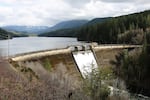With just a few weeks to make the decision, two key members of Portland’s City Council say they are undecided on whether the city and its ratepayers should spend up to $500 million building a new water filtration plant or choose a more affordable ultraviolet light system estimated at $110 million.
The Portland Water Bureau is weighing the two options to comply with a federal rule that it treat the city’s main drinking water supply for cryptosporidium, a single-celled protozoan parasite. It can cause severe diarrhea in healthy people but can be more serious for those with compromised immune systems.
The Water Bureau treats its water with a combination of chlorine and ammonia to kill other pathogens, but cryptosporidium can survive that process.
The Oregon Health Authority has ordered the Portland Water Bureau to report which treatment option it has chosen in a little over a month, by Aug. 11.

Bull Run Watershed
Amelia Templeton / OPB
Water Bureau staff laid out costs and benefits for the council to consider in a presentation on Tuesday.
Mayor Ted Wheeler and Nick Fish, the commissioner who oversees the Water Bureau, both indicated they think filtration is the better long-term choice for the water system, but they may be unwilling to pursue it in the short-term because of the cost.
“There’s not a question, if money were no object we’d move today on the filtration system,” Wheeler said. “But money is an object. Every dollar we spend on this system leads to increased water rates for users throughout the metro area, so I have to balance these two competing interests.”
Portland, like many American cities, has repeatedly increased water rates for users to cover the cost of replacing aging infrastructure and to fund new construction driven by tighter federal regulation of drinking water safety.
Portland’s main drinking water supply comes from a pair of reservoirs in the pristine and protected Bull Run watershed, a drainage in the Mount Hood National Forest.
Related: Why Portland's Water Hasn't Gotten The Lead Out
In recent years, the Water Bureau has spent hundreds of millions building new covered reservoirs to comply with the EPA regulation known as the Long Term 2 (LT2) Enhanced Surface Water Treatment Rule, which also set standards for cryptosporidium treatment.
In 2012, the Water Bureau received a waiver to the LT2 cryptosporidum rule. It allowed the bureau to avoid building new treatment facilities, so long as the concentration of cryptosporidium detected in the city’s main water supply, the Bull Run reservoirs, remained close to zero.
After 14 water samples taken from the Bull Run this winter tested positive for low concentrations of the protozoa, the Oregon Health Authority announced it was revoking the Water Bureau’s waiver, and ordered the city to identify a treatment plan.
Among the options under consideration, the cheaper option is an ultraviolet light treatment plant that uses short wavelengths of light to kill microrganisms, including cryptosporidium, by disrupting their DNA.
Seattle and San Fransisco have built ultraviolet plants to comply with the EPA’s LT2 rule, and five years ago, the Portland City Council directed the Water Bureau to develop plans for a UV system as a hedge in case the city didn’t receive its waiver.

Cryptosporidium parvum
Michael Wunderli/Flickr
“What you see in front of you here, on this table, is 700 pages of drawings. And what you see behind you, on a stack that is knee-high, are the specifications for a UV plant,” Water Bureau Director Mike Stuhr told the council.
“This pile of paper is worth $16 million, so you have a UV design on the shelf," he said.
Thanks to those existing plans, Stuhr said the city could complete construction on a UV plant at the Bull Run’s headworks facility within five years, at an estimated cost of $105 million.
The bureau’s second option, a water filtration plant, would take longer to design and build: 10 to 12 years. It would cost an estimated $350 to $500 million, depending on the type of filtration technology.
A filtration system would also incur higher maintenance costs, $4 to $5 million annually, compared to $2.5 million annually for the UV plant.
Filtration is the standard treatment the EPA requires of large public water systems that draw drinking water from lakes and streams. Portland is among five large cities that have a waiver from the filtration requirement, based on the high quality of the water in the Bull Run.
“If I was made of money, and I had a printing press on the third floor instead of a billing machine, I would build a filtration plant and I wouldn’t think twice about it,” Stuhr told the commissioners. “It does so many things for us.”
Filtration, which removes dirt particles as well as pathogens, would provide the city considerable long-term benefits beyond removing cryptosporidium.
It would be helpful in an event that led to increased turbidity, or dirt, in the Bull Run reservoirs. Forest fire, flooding and earthquakes could all trigger landslides and increases in turbidity in the Bull Run, threatening the city’s main drinking water supply.
Related: Military Airstrips Are Poisoning People's Wells
Building a filtration plant would also, in effect, increase Portland’s water supply, allowing the Water Bureau to pull water from deeper, murkier layers of its reservoirs.
“What makes this harder is the benefit of filtration, in terms of meeting current and future regulatory requirements and dealing with unforeseen events, is very significant,” Fish said. “And it is the approach of cities throughout the country.”
Stuhr told the commissioners he personally favored the cheaper ultraviolet treatment option, due to the “stiff burden” of costly projects water ratepayers are already funding.
But he suggested the council should begin, in the next budget cycle, setting aside funding for a long-term plan to build a filtration system.
The city council is scheduled to vote on a resolution choosing a treatment option on Aug. 2.
